|
Too Little Power
Some people claim that too little power can blow speakers. This is absolutely WRONG.
Too little power will only cause the maximum output level to be low. Abuse and the defective 'wing nut' (an idiot) connected to the volume control blow speakers with low powered amplifiers. If driving a speaker with low power would cause them to fail, speakers would fail every time you lower the volume on the head unit. I will try to explain what happens when speakers are driven with badly clipped signals (minor clipping is not harmful).
Note:
This page deals mainly with speaker damage that involves thermal damage of the voice coil. Speakers can also be damaged mechanically by driving it beyond what the suspension can handle. Mechanical damage is generally caused by driving the speaker with too much power but it can also be done when a speaker is in a ported enclosure and is driven with frequencies below the port tuning frequency. Most of the damage I've seen has been thermal damage to the voice coil.
Damaging Woofers:
When a woofer is driven with a high powered amplifier to high levels, there will be a significant amount of current flowing through the voice coil. Since the voice coil has resistance, there is a voltage drop across the speaker's voice coil (which the amplifier appreciates greatly :-). This means that there may be a great amount of power being dissipated (in the form of heat) in the voice coil. When a speaker is driven with lots of clean power, the cone moves a great deal (in proportion to the output voltage from the amplifier). For speakers with vented pole pieces (or other types of venting), this movement forces a lot of air to flow in the magnetic gap (area where the voice coil rides). When the woofer moves out of the basket, the chamber that's under the dust cap and around the voice coil expands (increases in volume) which pulls cool air into the magnetic gap. When the woofer moves the other direction, the chamber size is reduced and the hot air is forced out of the vent in the pole piece. This air flow cools the voice coil. If a relatively low powered amplifier is driven into clipping (to a full square wave for a lot of people), a relatively large portion of the time, the voltage delivered to the voice coil no longer resembles a sine wave as it would with an unclipped signal. While the amplifier's output is clipped, the voice coil is not being motivated to move as far as it should for the power that's being delivered to it and therefore is likely not being cooled sufficiently (since the speaker is driven by a linear motor, the voltage applied to the voice coil determines how far the voice coil moves from its point of rest). At points a, b, d, e, f and h the voltage is changing causing the voice coil to move in the gap and therefore pull in fresh cool air. At points c and g, the voice coil may still be moving a little due to momentum but may not be moving enough to cool properly. Remember that during the clipped portion of the waveform current is still flowing through the voice coil. Since the displacement of the voice coil (and therefore the airflow around the voice coil) is no longer proportional to the heat being generated, the voice coil can overheat. This excess heat may cause the voice coil former to be physically distorted and/or melt the insulation off of the voice coil wire and/or cause the adhesives to fail (especially if the speaker is rated to handle no more than the power that the amp can produce cleanly). If your speakers are rated (honestly) to handle the maximum 'clean' power that your amplifier can produce, slight clipping isn't generally a problem. Severe clipping is more likely to cause a problem.
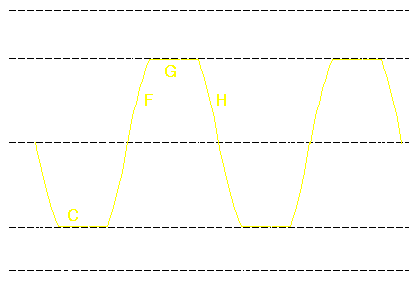
Severe Clipping (square wave):
It always amazes me when I hear some idiot driving down the road and the audio is clearly distorted (is that possible :-). Many people drive their amplifiers into what could be called a square wave output (white line below). When an amplifier is pushed that hard, it is actually possible to drive the speaker with twice as much power as the amplifier can cleanly produce into the speaker. As you can see below, the yellow sine wave is the maximum 'clean' output that the amp can produce. When an amplifier is pushed way too hard, the signal will eventually look like the white line. The effective voltage of the white line is ~1.414 x the yellow line. This means the the total power driven into the speaker by the clipped (square wave) signal is double the power delivered by the 'clean' signal (yellow line). This means that the power is double but the cooling of the voice coil will not increase in proportion with the power increase (since the voice coil isn't moving as much as it needs to be for the given power dissipation). This will lead to the voice coil overheating. If we compared the output of a 100 watt amp (the one that's clipping) to a 200 watt amp, the 200 watt amplifier would be able to push the speaker as much as 40% farther than the 100 watt amp (depending on the frequency of the signal). This extra travel (in each direction from its point of rest) would result in added airflow around the voice coil.
Note:
The RMS voltage of a pure sine wave is equal to the peak voltage multiplied by 0.707. The RMS voltage of a pure square wave is equal to the peak voltage. For 2 waveforms with equal amplitude (as shown above), the RMS voltage of the square wave is 1.414 times the voltage of the sine wave. If we use the example of the 100 watt amp which can produce a sine wave of 20 volts RMS, we can see that the output power at hard clipping is double the power it can produce cleanly.
Clean Signal Calculations:
P = E^2/R
P = 20^2/4 (4 ohm speaker)
P = 400/4
P = 100 watts RMS
Square Wave Signal Calculations:
P = E^2/R
P = 28.28^2/4 (the RMS voltage is 1.414 times the RMS voltage of the sine wave)
P = 800/4
P = 200 watts RMS
If you need more info about peak, peak-peak and RMS waveforms, click here.
Note:
As I've said somewhere else on the site, there's actually no such thing as RMS power. The proper term is average power. I use the term RMS power anywhere that RMS voltage is driven into a resistive load. The purists just hate when someone uses the term RMS power. Since the term RMS power is used by most everyone in the industry, I'll use it here also. It may not be technically correct but it's less confusing for some.
In the following table I drove a speaker with an amplifer in full clip (square wave) at 3 different frequencies. In each case I measured the voltage across the speaker terminals with a true RMS volt meter. To get equal power from the square wave signal AND the 'clean' signal, I took the voltage reading from the square wave signal and multiplied it by 1.414 and used that voltage (peak voltage) for the clean signal. The RMS readings for the square wave and the sine wave were the same. Both the square wave and the sine wave would produce approximately the same power dissipation in the voice coil and therefore the same heat output. As you can see, the square wave signal did not move the cone as far as the 'clean' sine wave signal. Since the cone has more excursion with the clean signal, the voice coil will have more air flow which will result in more cooling (especially for woofers with vented pole pieces). The woofer was a long excursion unit made by Eminence. The excursion measurements are all in one direction. The voltages below were the peak AC voltages as read on the scope. The output voltages vary with frequency due to the impedance variations of the speaker at the different frequencies.
|
Test Data
|
|
|
'Square Wave' Voltage
vs
Excursion
|
'Clean' Voltage
vs
Excursion
|
Difference
in
Displacement
|
|
60 Hertz
|
23.6vac
0.32"
|
33.4vac
0.49"
|
0.17"
|
|
45 Hertz
|
23.8vac
0.33"
|
33.6vac
0.46"
|
0.13"
|
|
30 Hertz
|
21.8vac
0.29"
|
30.8vac
0.39"
|
0.1"
|
-
Note:
-
If your speakers are capable of handling significantly more than your amplifier can produce, driving them with a clipped signal will not likely hurt them.
-
If the speakers can handle 3 or 4 times the power that your amplifier can produce, there's virtually no way to damage your speakers (no matter how clipped the signal is).
-
If your speakers are rated for the same power handling as your amplifier is capable of producing cleanly, driving them with a clipped signal for extended periods of time may cause speaker damage and/or premature failure.
-
If your speakers are rated for the same power handling as your amplifier is capable of producing cleanly, driving them with a square wave signal for extended periods of time will likely cause speaker damage.
For more information on speaker ratings, click here.
Damaging Tweeters:
There are several factors that will determine whether or not clipping will cause damage to tweeters. If the tweeters are connected directly to the amplifier (no passive crossover) and the amplifier is driven into clipping, the time that the signal is clipped, the tweeters' voice coils will be subjected to short bursts of undesireable power. This will cause undue/unnecessary heating of the tweeters' voice coils. More severe clipping will cause even more undue voice coil heating. The following is what the tweeter will 'see' when the amplifier clips. The flat parts of the waveform indicate clipping.
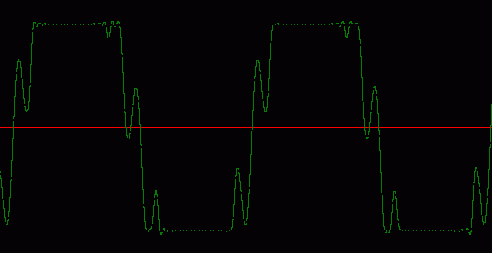
If the tweeters are connected to a passive crossover (passive crossover between the amp and the tweeter), the clipping may have little or no effect on the tweeters' reliability. When the amplifier clips, there will be essentially no instantaneous output from the crossover (during the time the amplifier is actually clipping) and there will be virtually no voice coil overheating from the clipping. The only additional power going to the tweeter (during clipping) may be from harmonics. When amplifiers are pushed into clipping, harmonics are generated. Many times these harmonics are similar in frequency content to the high frequencies which are allowed to pass through high pass passive crossovers. When the harmonics pass through the xover, they will be responsible for only slightly more power being generated in the voice coil (the harmonics are not going to cause the tweeter to fail). This slight increase in power that the speaker receives from the harmonics is nothing compared to the power generated during clipping (if the passive crossover were removed from the circuit). The following signal is the same signal as shown in the previous example but after it is passed through a high pass passive crossover. You can see that there is no clipping component. If you're continually blowing tweeters and they're connected directly to your high end amplifier (even though you have the electronic crossover set to the right frequency for your tweeters), adding a passive crossover (even a simple first order filter) in series with the tweeter may help save your tweeters.
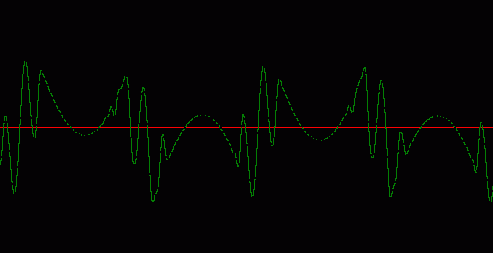
|
This diagram shows both waveforms, the average power for the top waveform is approximately 10dB more for the waveform where the tweeter is driven directly by the amplifier. This means that... if the bottom waveform is producing 10 watts of power across the tweeter's voice coil, the tweeter connected directly to the amplifier will be receiving 100 watts and producing no more audio but the tweeter is definitely more likely to fail.
|
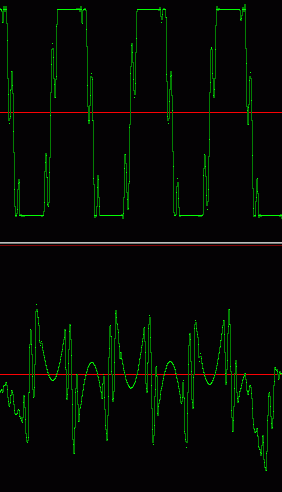
|
-
Note:
-
The system shown in this example could be improved by increasing the crossover frequency, using both the electronic and passive crossovers or using an amplifier with more headroom.
-
Unless the amplifier is rated for SIGNIFICANTLY higher power output than the tweeter is capable of handling, the tweeter will not instantly blow if the amp is driven into clipping. This is especially true when using both active and passive crossovers in combination.
-
If the tweeters are rated (honestly) to handle significantly more than the amplifier can produce, driving the amp into clipping may never damage the tweeter.
-
If someone says that clipping will definitely blow tweeters and someone else argues that clipping will never blow tweeters and no more information is given in the argument, chances are pretty good that neither of them know what they're talking about (or at the very least, they're not looking at all of the different possibilities).
Tweeter Protection:
There are a few people who can not hear when a tweeter is being overdriven (even if it's obvious to everyone else). Those people need tweeter protection. Many manufacturers use a lamp to limit the current passing through the tweeter's voice coil. The lamp allows normal operation at low to moderate volume but, as the the filament in the incandescant lamp heats up, it's resistance increases. The following graph shows how the power going to the tweeter is significantly reduced at high power but is affected little at low power. The lamp I used would be good for tweeters rated for 10 watts or less. To allow more power to get to the tweeter, you'd choose a lamp with a higher power rating.
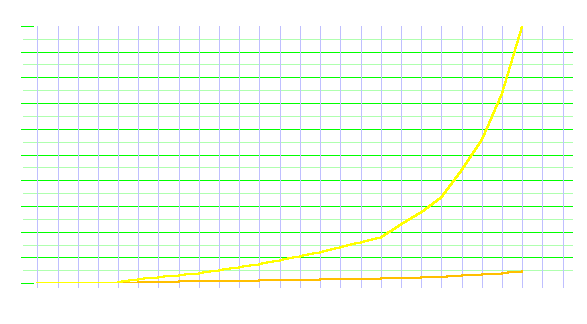
Test Lamp Information
Sylvania 211-2
|
|
Resistance Cold:
|
0.85 ohms
|
|
Current @ 13.86vdc:
|
1.05 amps
|
|
Power:
|
14.55 watts
|
-
Data
The following shows:
-
The voltage generated at the amplifier's speaker terminals
-
The power that the above voltage would produce into the 4 ohm load used in the test (if the lamp were bypassed)
-
The current flow through the load and lamp
-
The power actually driven into the load
-
The voltage across the load
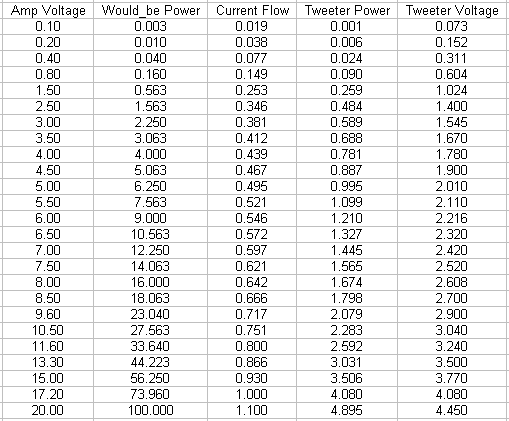
This is VERY Important
The best protection for your speakers is to use a little common sense. Just because your head unit's volume control goes to 35, that does not mean you can set it at 34 and expect no clipping. It doesn't even mean that you're going to be safe at 25. Depending on the gain settings, the head unit's tone control settings and the music source, you may be able to drive the system into clipping at virtually any point on the volume control. Listen carefully for distortion and stress.
Test tones clipped:
The following .wav files are a 100hz and a 1khz test tone played 'clean' for one second, then clipped for one second and is repeated 3 times. They may take a few seconds to load. Please be patient.
Note:
If your computer uses winamp to play the wav files, it will have a spectrum analyzer. In the display, you can see the harmonics come into view when the signal is clipped. It appears as little spikes at frequencies higher than the fundamental (the fundamental is leftmost and the harmonics are to the right of it at regular intervals). It is especially apparent in the 1000hz file.
Warning!
Set the volume control on your computer to approximately 10% of its maximum level before clicking on the links below. Adjust the volume as needed after the file has begun playing.
1000Hz 100Hz
Music Clipped:
The following link is a sample of music in MP3 format. The left channel is severely clipped. The right channel is clean. Use the balance slider on your MP3 software to shift from left to right. In the picture below, you can see that the top (left) signal is clipped and the bottom (right) signal is not. The image was taken directly from the wavefile that was converted to the MP3 file below. When listening to the file, pay special attention to the bass drum track.
As a side note...
Even though the signal is severely clipped, it can be difficult to hear at some points in the track. When you hear someone driving their amplifiers so far into clipping that it's clearly audible, you'll know that the waveform that's being sent to the speakers doesn't even resemble the original waveform.
Clipped Music
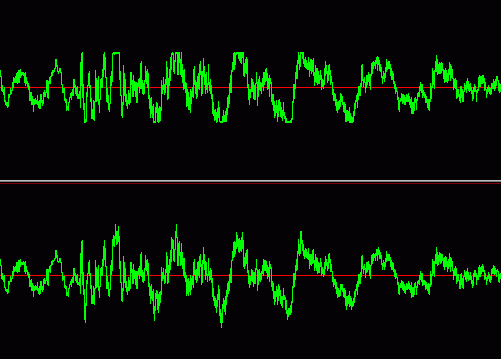
|











